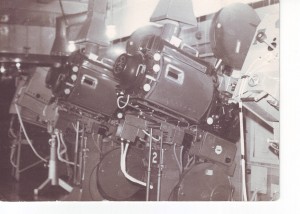
ABC Chester projection department 1965

_______________________________________________________________________________________________________________________________________________

Projection Room 1912
In the silent days before 1910 the projectionist was in the auditorium with the patrons. The projector would be in the aisle and the operator would operate the projector by turning an handle. The film would usually fall into a basket. The film was nitrate base so could easily go up in flames. This happened on numerous occasions. In 1910 it became law that projection equipment had to be housed in a separate area from the audience. So, cinemas had to construct projection rooms containing fire proof shutters. Also there had to be a bucket of water, a bucket of sand and an asbestos blanket, as fire precautions. The projection room had to be separate from the rewind area. Only film on the projectors was allowed in the projection box. This practice was kept until the introduction of safety base in the fifties. Then it was allowed to rewind film in the projection box.
Another strict rule was no smoking, and signs would be placed in the projection and rewind rooms. Staff in a projection room in the early days would be three or four people a shift. There would be one man turning the handle between sixteen and eighteen frames per second, another would be attending to the carbons, having to constantly feed them, as there was no automatic feed at that time. Another would be taking care of rewinding.

Sound on disc system
Projection work could be a little on the unhealthy side due to carbon dust being inhaled when cleaning arcs, carbon fumes being breathed in before extraction was fitted, possible exposure to asbestos, which was used on cables connected to the equipment, and the dangers of some early machinery with a front flicker shutter that wasn’t encased, and could do damage if contact was made. There were also cleaning fluids that were suspect where health was concerned and the dangers of rewinding poor prints that could make a nasty cut to your fingers.
In the nitrate days films were shipped in 1000ft foot rolls giving eleven minutes running time. These would often be joined together into 2000ft rolls by the projectionist, using film cement. Tape joiners were a long time into the future. Projection rooms varied in size, some having limited movement. In 1932 The Bioscope magazine reported on the opening of the Dominion Hounslow, stating that it has one of the largest projection rooms in London. It was equipped with Walturdaw and Western Electric sound.

1928 Ross 35mm projector
There were several makes of projector including Kalee, Simplex, Kamm, Empire and BTH, made in Rugby. Kalee machines were made in Leeds by Kershaws, and Simplex was made in New York by the International Projector Corporation. Exhibitors found themselves paying out huge sums to install sound. You could buy the disc and optical system or just the optical system. In 1929 a Cinephone disc and optical system cost between £1500 to £1950. Easy terms were usually on offer.
The cinema has come a long way from those early days. We have seen wide screens, 70mm, safety base film, polyester film stock, non rewind systems (cake stand) and towers, eliminating changeovers, magnetic sound tracks, Dolby Stereo, Dolby Digital and now digital projection. Most cinemas have removed their 35mm equipment and most has been skipped. Fortunately there is the Projected Picture Trust (PPT) who have saved equipment and have examples of all machines at their headquarters in Halifax.
David A Ellis©chestercinemas.co.uk

35mm-Film-with-Optical-Sound-Track
35mm film has four sprocket holes each side to a frame, and there is sixteen frames to a foot. Because there are four sprocket holes, the film must be laced in frame or rack. All machines have a framing or racking handle that moves the intermittent sprocket, allowing framing to be adjusted. Normally the framing handle wouldn’t need to be moved unless the picture was out of frame. Projectionists would have to adjust the framing, if for example a 4×3 ratio picture was shown in wide screen ratio. The framing sometimes had to be adjusted to show heads that were missing due to it being shown in the wrong ratio. Unfortunately many cinemas only had two ratios, scope and wide screen – and then only one wide screen and scope ratio. A few were equipped for several ratios, so avoiding cropping heads and titles. In fact a 4×3 ratio film had more frame area than wide screen ratio film. With a 1.66:1 ratio, often used by Disney there were thick black racking lines, so the picture area was a lot less than 4×3. Because the picture was screened wide screen it gives the impression you are looking at more picture, which you aren’t. A projectionist, when screening a film had to stand by the projector at all times, holding the handle (dowser), which closed off the light. To screen a feature two projectors were required. Rolls of film on wooden and later plastic bobbins were shipped to the cinema. The projectionist or operator would join two 1000ft rolls together, giving twenty-two minutes running time. Films would be joined using a splicer and film cement. The operator would scrape the emulsion off one piece of film and rub the shiny side, and then put the cement on, which was a strong smelling liquid. The splicer would bring the two pieces of film into contact, hopefully making a strong join. Much later, tape joiners were employed. In the nitrate days a feature lasting around ninety minutes would consist of ten rolls of film.

In the 1950s, safety base film arrived and rolls were sent in 2000ft rolls. The films arrived in a metal transit case, delivered by Film Transport Services (FTS). Films were sometimes shipped by rail. The rolls were housed in tin cans, later changing to plastic containers. The rolls of film were transferred on the rewind bench to spools.
The Projection Room
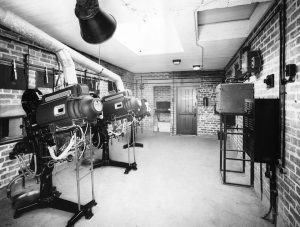
Projection room~ TATLER/Classic
The spools are placed in the top spoolbox of the projector and the film is threaded or laced by the projectionist through the projector and sound head, then placed into the take-up spool. Loops are made to allow for the stop/start motion of the film. If there weren’t any loops the film would just break. The 35mm film runs through intermittently at 24 frames per second (fps), 18 inches per second or 90feet per minute, which gives 22minutes-running time on a 2000ft spool. A flicker shutter was employed to cut light off when the film was in motion. Some projectors had front, some rear. If the shutter went out of sync (out of phase) there would be streaking that was very noticeable on light scenes and titles.
The sound is nineteen and a half frames ahead of the picture. It can’t be printed where the picture is shown due to the intermittent movement. Carbon arcs used to provide the light source. There was a wide choice of lamp houses. These included the Kalee Vulcan, Kalee Regal, Ashcraft, Mole Richardson, Kalee President, Kalee Lightmaster and Peerless Magnarc. The President and Lightmaster would often accompany the Kalee 20/21 machines. The carbon arc consisted of a mirror to reflect the light and a motor to feed the carbons. A card placed on the top of the lamp house allowed the operator to see if his carbons were adjusted correctly. In large halls some projector gates were water cooled because of the high amperage. The Mole Richardson lamp house was water-cooled. Rectifiers were used to convert AC to DC for the carbon arcs. Some were solid rectifiers, placed behind the projector, others were the mercury type.
Click on the frame below to understand the basics of how a 35mm cinema projector worked

Traxler video
Click on the frame below to follow the lacing of 16 projectors interlock using just one film

Mercury Rectifiers
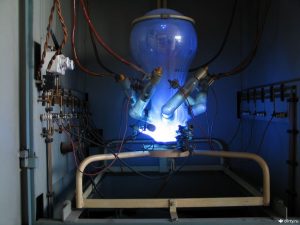
The mercury arc rectifier looked like something from a science fiction film. It was a bulb filled with mercury, which glowed. Some cinemas had one rectifier so a light drop would occur when striking the second arc. Some had two Later, many switched to xenon lamps. Some carbon arcs were converted to xenon, for example the Peerless. A changeover system was employed to change from projector one to projector two, without creating a break. Cue marks covering four consecutive frames were printed on the film, which would appear in the top right hand corner of the screen. These let the projectionist know when to changeover. Some projectionists would add their own cues adding crosses that almost covered the frames. Punching holes in the frames was another practice by bad projectionists. On the first cue the operator would start the motor and open the lamp house douser. Eight seconds later the over cue would appear. The projectionist would then open the shutter and change the sound over. A good changeover would look like a scene change.
Cinemation
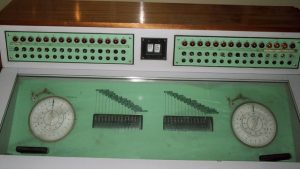
Some cinemas fitted automation units, such as Projectomatic, originally Essoldomatic, invented by the Essoldo cinema chain, which controlled changeovers, tabs, house lighting and non-sync. Projectomatic had one drum that had pins in it, which operated switches that did the various operations. To activate the drum, silver tape was attached to the film. Cinemation (pictured above) was a more advanced system, the brain child of Bernard Bentley, and installed in Rank cinemas, using two drums. This could do all that projectomatic could do and more. Cinemas went on to fit long running equipment. This was the end of the changeover for those cinemas. There was the tower system where the film had to be rewound and a non-rewind system known as a cakestand. The projectionist had to be careful with these systems as the film was run through rollers around the projection box before being threaded.

The Chester Odeon projection team 1940s

The daily maintenance routine for trained Odeon projection staff. Click on the above frame to play
There were many makes of projector. Among them was British Thomson Houston (BTH), which all Odeon cinemas installed. Odeons first employed type A projectors with type B arcs. Later, in the 1940s they installed the SUPA, which stood for single unit projection assembly. This machine had everything built in; including amplifier and the take-up spool ran anti clockwise. Later, many Rank cinemas used Kalee 21 machines before using Cinemeccanica in the mid 1960s. Many installed the dual gauge Victoria 8. Associated British Cinemas (ABC), mainly used Ross projectors. Later, they switched to Philips FP20s. Philips also produced two dual gauge 35/70mm machines, the DP 70 and 75. The 70 was the only projector to win an Oscar. Simplex was an American machine and one of the good things was the masking or aperture plate could be changed while the machine was running. Westar and the range of Kalee projectors were also popular. The Rolls Royce of Kalee machines was the Gaumont Kalee 21, arriving in 1947. These would be employed in nearly all Gaumont Theatres. Many of their theatres had previously used the Gaumont Eclipse machine with a sixteen-inch turntable on the back, used for sound on disc. The discs ran at thirty-three and a third RPM but the stylus was placed in the inside, at the end on a conventional disc.
Sound Systems

RCA sign from the Tatler/Classic, given to Roger Shone by Jack Lightfoot, the final chief projectionist.
Sound systems included Radio Corporation of America (RCA), Western Electric, British Acoustic and British Talking Picture. Sound was optical, variable area and density being mono only. On an area track you could see the intensity of sound by the lines on the track. To get an optical track in sync the loop below the intermittent sprocket had to be the right size. If it was, a diamond, which is printed on the leader, would be in line with the optical system in the sound head. If the loop was too big, sync would be affected slightly. A lamp called an exciter lamp would be employed to focus on the track. This would shine on the track and would pass through a photoelectric cell, turning the light into electrical current that went to a pre amplifier before being fed to the main amplifier. Sound heads were usually designed to carry two exciter lamps, allowing a quick change if there was failure.
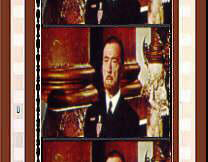
When cinemascope arrived in 1953 Fox released films carrying four magnetic sound tracks. The film also carried a half optical track. Theatres not equipped for four track would be sent an optical only print. The sprocket holes were smaller on these prints and were known as Fox Hole. Strangely enough, films carrying these tracks were advertised as being in stereophonic sound when stereo is only two tracks and four would be quadraphonic. The sound head was above the projector head and with these prints you had to make sure you didn’t erase the track. Also shedding of the oxide could be a problem.
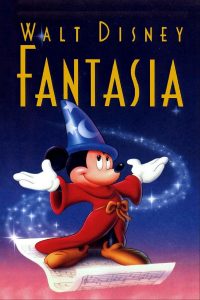
Stereo sound wasn’t new in cinemas, back in 1953. In 1940 Disney’s Fantasia was screened using four optical tracks on a separate reel. In the 1980s we had Dolby stereo. This was optical sound that carried four tracks and was split and fed to four amplifiers. The last optical tracks to be used were cyan tracks using what was known as a red reader instead of the original exciter lamp. DTS was used. This is a CD disc that runs in sync with the film, an advanced version of sound on disc. Even if the film were cut, sync would still be kept, because time code is used. There was also Dolby Digital. There was a digital sound head fitted above the projector head. Information was between the sprocket holes on the optical soundtrack side. Theatres that weren’t equipped for Dolby Digital could use the stereo optical tracks.
The projectionist had to put programmes together, keep an eye on the film running through the projector and make sure the light from the arc lamp was ok. Carbons could jam together making the picture fade to nothing. This problem was eliminated with xenon lighting, though some say the light isn’t as good as carbon arc.
In the 1950s projectionists were given several wide screen ratios to work with, including Cinemascope, which used a lens called an anamorphic to stretch a squeezed print to normal on a wide screen. There was a backing lens that was behind the anamorphic.

__________________________________________________________________________________________________________________________________________

The ABC of 3D ‘kits’~ Alan Ashton’s insight of how the ABC circuit presented 3D
The days of 3D and an exercise in seeing how ABC would get away with as little extra cost as possible.

The tripods stands and the rewinders were jacked up on blocks, and the entire 3D ‘kit’ ie: connecting bar / filters & cooling blowers / lamphouses / spools all had to be dismantled and shipped off to another location at the end of every run of a 3D presentation. ABC had several of these transportation ‘kits’ which saved a fortune on converting the drive motors to an electronic Selsyn interlock.

It didn’t make for easy working when lacing up Projector A because the bar cut across to Proj B. In the middle of the bar, there was an aperture that allowed you to insert an Allen key and de-couple the two machines so that they could be used in the normal way for the remainder of the non-3D portion of the show.
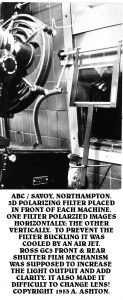
When it came time for the 3D feature you laced up BOTH machines each with the leader Fig 8 in the gate. Once checked the bar was then coupled up and both machines would then start and would run: courtesy of the new Peerless arcs for approx 40mins.

Then came the intermission and you laced up both projectors with the second half of the show. Operational facilities were not always universal across the ABC circuit.
On a humorous note; many of the pensioners who came in for the matinees either walked out or complained to the usherettes that the film was blurred. It was pointed out to them that they had to wear the polarized glasses ( which had to be collected and sanitized as they exited and were reused for the next show ) Therefore there had to be 3 separate performances each day instead of continuous.
Alan Ashton ©
_____________________________________________________________________________________________________________________________________________

Short lived, but good….
To attract audiences many ideas came to fruition only to fall by the wayside in a very short time. We have had 3D, which has appeared several times in different forms. In the 1950s two projectors were locked and ran together with 5000ft spools, giving fifty minutes running time. Because of this, an intermission was required. The audience wore 3D glasses, which in some cases could put a strain on the eyes, so while the system was impressive it went away for a while after its 50s introduction. Now we have digital 3D and digital Imax, which is not as impressive as 70mm Imax with its fifteen perforations to the frame and runs horizontally. Maybe digital Imax will have a longer shelf life than film Imax, because of lower costs, not having to produce expensive prints, and only a few houses being able to screen it. It is easier to screen digital Imax in many more theatres, but in most cases the screen is smaller. We have had three strip Cinerama, which proved costly and only a few could screen it, so because of the costs and limited exhibition it soon fell out of favour. Three strip was replaced by 70mm Cinerama, which is also no more.

The Odeon Leicester Square was kitted out with horizontal VistaVision for the screening of Battle of the River Plate but the equipment was only used there once. Director of Photography on the film Chris Challis told me he was glad to see the back of it as it was a difficult system to work on.
We have had Smell O Vision which put out pleasant and probably not so pleasant aromas into the theatre. Again this was short lived, apparently only being used for the film Scent of Mystery in 1960.

Shown at selected cinemas in Sensurround
Sensurround was another short lived experience where you would feel vibration in your seat, which was delivered by low frequency, giving you the feeling you were experiencing an Earthquake in the film of the same name. Unfortunately the vibrations had adverse effects on the structure of some of the cinemas it was screened in. This was soon consigned to cinematic history.
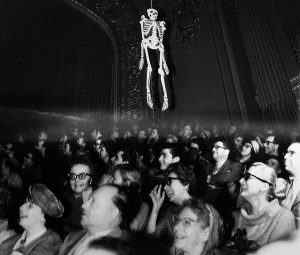
Emergo’s flying skeleton over the audience.
Another gimmick to attract paying customers was to put a skeleton on a wire which would be reeled out to an unsuspecting audience making them jump from their seat. This was put to use on the film The House on Haunted Hill and the gimmick called Emergo.
Around the World in Eighty days was screened at the Astoria Charing Cross Road, London in 1957. It was shot in 65mm using Mike Todd’s Todd AO process but screened in 34mm with six track magnetic sound played on separate sound carriers, which had to be locked to the projectors by Selsyn lock. The reason for this was because of the 34mm print to avoid British Quota rules at the time. The projectors employed for this gimmick called Cinestage were the popular Kalee 21 machines accompanied by water cooled Mole Richardson arcs. The gates were also water cooled. There were five Duosonic speaker assemblies. There were more than forty effects speakers.
Today it is harder to impress the cinemagoer because we now have large wide screen TV’s and equipment that can give us a full stereo and surround sound experience, and there is an endless supply of films to be streamed both old and new.
What other gimmicks will make a splash only to sink into cinematic history very quickly?
David A Ellis©chestercinemas.co.uk
______________________________________________________________________________________________________________________________________

I suppose most people take for granted surround sound and comfortable seats in our multi cinemas now. Perhaps we should remember the time when for decades cinemas had only mono sound delivery from big speakers behind the screen. Do not forget this sound had to be able to reach people’s ears right at the back of the circle and be good quality in an area to seat 2000 people .It might not have sounded as good as today’s sound but showing the film OKLAHOMA I thought it sounded smashing! And don’t forget some of today’s cinemas only have around 200 seats, no wonder sound is great!
One evening back around 1958 while showing the current films of that week, the manager came into the projection room with some chaps from the local photo club. The manager (Mr Woodman) told me this group were pestering him about having a look at what our job consisted of; to say they were blown away is an understatement. They asked about the amplifiers which were under a door in the side of our BTH SUPAs. They wanted to know what amps output was used to drive our speakers. Of course, large London cinemas did have stereophonic sound here and there.
I remember around October 1956 chief asked me to take something (probably a can of thawpit cleaning fluid) over to the Odeon Barking, strange how you remember things like, I know we were both showing ,THE SOLID GOLD CADILLAC, with Paul Douglas & Judy Holiday at that time… Going up to their box and talking to one of their operators, they had stereo equipment fitting just under the top spool box. I was told the magnetic sound was printed on the outside edges of the 35mm print (unless someone knows different) Barking Odeon at that time could put on live shows at the weekends I went once (complimentary ticket) as another good friend Reg Harris was working on the spot lights for the show, not sure but I think Shirley Bassey was appearing.

The Cinemiracle projection layout.
In early 1958 Odeon Tottenham Court road was converted to show a Cinerama like 3 projector process called CINEMIRACLE. I think J.A. RANK wanted to compete with CINERAMA round the corner at the casino theatre in old Compton Street. The Odeon was going to show CINEMIRACLE had to have 700 seats removed. This was done so they could fit a screen 71 feet wide by 28 feet high. In early 1958 our 2nd operator Tony Phillips was asked if he wanted to be included in the projection team showing the new show in London, Tony was delighted and said yes.

Later that year Tony gave me two tickets to see the film WINDJAMMER which was the only film shown in CINEMIRACLE ever at this Odeon. Would you believe they had a band playing music before the film started! As Dorn (my future wife) who was an usherette at my Odeon and I had only just started courting at this time it was great to take her with me. We both enjoyed the programme, the sound was really impressive. It was Tony’s day off at this time so we could not look around the projection room, shame! One thing about our visit was as we came out of the cinema Dorn put her arm in mine for the first time, magic! Sad to say this project only ran from the 14th of May 1958 till 1st of November 1958. Tony Phillips, who was a good friend of mine, married a nice girl called Jane who you would believe was a projectionist around the Gaumont East Ham! It seems all the nice girls worked at all our cinemas!
James Jee©chestercinemas.co.uk
________________________________________________________________________________________________________________________________________________
Digital

A rather basic digital installation at the Sealand Road, Cineworld
Now all cinemas are equipped with digital projection, not a frame of film in sight. The plus side is no dirt, scratching or weave. No matter how many times it is screened the quality remains the same. A film can be screened in several auditoriums at the click of a mouse, no need for several copies. Once the film is on the central (TMS) server it can be moved to each individual server in any screen.
I myself was a cinema projectionist and it is sad that this trade, like so many others has been confined to the scrap heap. There was something about handling film, and being able to physically see images. Showmanship where a projectionist could provide a fantastic cinematic experience has gone. Curtains (tabs), which hid a blank screen, are no longer used in cinemas. Curtains hiding the screen added to the cinematic experience. A blank screen doesn’t do anything for showmanship. Also masking, which masked the rough edges that were projected because of the masking (aperture plate) are no longer used in many cinemas.
I will miss film but in several years time people will only find it in museums. How sad.
David A Ellis©chestercinemas.co.uk
________________________________________________________________________________________________________________________________________________________
Film Stock

When 35mm film was introduced in the 1896 it had a nitrate base that needed to be handled with great care. If not there was a strong possibility that a fire could take place as the base was highly flammable. No smoking in the projection room was strict requirement. It was because of film bursting into flames that separate projection rooms became a requirement from 1910.

Nitrate film
Before this, equipment was placed in the same area as the audience. A separate rewind area was also a requirement. Film that was only going to be projected was allowed in the box.
Safety base film arrived in the 1950s and some cinemas then did the rewinding in the projection room using the old rewind area for other things. Though the film was a safety base, no smoking rules still applied. In the silent days the full frame was used. In other words the area taken up by the soundtrack that came later, was part of the image. This ratio was known as 1.33:1. When sound arrived because of the soundtrack, a plate masking the soundtrack area had to be used. This meant there had to other adjustments so the picture could still be projected on to the same screen. This involved cropping slightly and using another lens. The film makers didn’t like their images being cropped so in 1932 The Academy ratio, 1.37:1 was introduced. This was near the 1.33:1 ratio. Slight changes to the frame area was required.
In the 1950s wide screen was introduced. There were several wide screen ratios. Film makers when shooting in a ratio they knew would be cropped would shoot with microphones in the frame. Many filmmakers knowing part of their images would be cropped were happy to shoot with objects in shot that would be cropped later. There was 1.85:1, 1.66:1 1.75:1. 1.66:1 consisted of thick frame lines. Disney shot a number of productions in this ratio. This ratio left very little room for framing (racking). Wide screen gave the impression that the picture was bigger than Academy (1.37:1),which it wasn’t. You could show an academy ratio film in wide screen, using wide screen plates and lenses but some of the image would be cropped, for examples titles missing. Otherwise it looks like any other wide screen presentation. So there is more picture area with academy than a 1.66:1 wide screen image.

In 1953 Cinemascope arrived. This used the anamorphic system. It was shot with an anamorphic lens and shown with one. In the early days of scope there would be annoying lines that would appear as a flash at the top of the screen when there was a cut to another scene. These were joins made by the neg cutter,which couldn’t be cropped as there was no margin for it. Early anamorphic systems distorted the image slightly.

Click on the above frame to watch the arrival of CinemaScope in the UK
With cinemascope came four track magnetic sound. Prints carrying these tracks also carried an optical track, which was reduced in size and volume levels were lower than normal optical tracks. The mag head was placed above the projector head unlike the optical, which was below. The operator had to be careful that the tracks were not magnetized. Films with magnetic tracks had smaller sprocket holes, known as Fox Hole. The projectionist had to make sure the sprockets were changed for this.
Scope required a backing lens and an anamorphic. Some Cinemas had a separate backing and anamorphic lens, others had them combined. If you mistakenly left the wide screen lens in and put the anamorphic in front of this there would be a very large image that would spread beyond the screen area,some projected on the front exit doors. A cinemascope image is a stretched image that covers, apart from the soundtrack area the whole frame with thin frame lines. The anamorphic unstretches the image to make it look normal. Apart from a change of lens the masking plate or aperture plate also has to be changed.
With four track magnetic, speakers were placed at the right, centre and left of the screen. There were also speakers on the side walls which played the effects track. 70mm film also carried magnetic tracks but there were six, giving even more realistic sounds. Cinerama had seven tracks played using a separate reel carrying the tracks. Years before Walt Disney produced Fantasia, carrying optical tracks on a separate reel for stereo. Another format in the fight against television’s affect was third dimension (3D). Two 35mm projectors ran together both carrying 5000ft of film. These films required an intermission as only fifty minutes could be screened in one go. Some cinemas found it a problem because of the length of time carbons would burn. Cinema engineer Jim Shultz said the best for this was the Peerless carbon arc. Glasses were required to view but some found them a strain and the novelty soon wore off.
In the 1970s Dolby Stereo came along. This wasn’t magnetic but an optical track carrying information for four channels. Later, Dolby Digital came on board, the sound head being above the projector head. DTS was another system. A compact disc would keep sync with the film. There was time code that meant even if a join was made sync would be kept, unlike the sound on disc days of early sound where a blank piece of film would have to be inserted. Exciter lamps with white light were used for optical sound until the red reader came along. Some say that the red reader doesn’t produce sound as well using the old tracks that were designed for the white reader.
Following on from safety base film there was polyester stock, which was so strong it was possible to pull a machine over. This stock prevented film breaks and the cry of ‘put a shilling in the meter.’ The cinema went through many changes. From two projectors to long running equipment and format changes, for example 70mm Imax with fifteen perforations to a frame and horizontal projection. Years before there was 35mm Vistavision, which some theatres projected horizontally. Also new sound systems such as Dolby Digital. All that technology has been cast aside to make way for digital. What will follow digital? A good question. What can follow something like that. I think from now on it will always be digital but improvements will be continually made.
David A Ellis©chestercinemas.co.uk
_________________________________________________________________________________________________________________________________________________________

“THIS WAY PLEASE” click on the above frame to view the video
_____________________________________________________________________________________________________________________________________________
Circuits and their equipment
There were a number of companies producing cinema projection equipment, some no longer existing. There was the Gaumont machines, including Eclipse and Chrono, Power projectors Kalee, producing a number of models, including 8s 11s 12s and 21, Kaplan, Westar, Simplex, Ernemann and others.
In this article we cover what the circuit cinemas used to bring about the magic of cinema.
The circuit cinemas mainly carried the same equipment for all their cinemas. Odeon were equipped with British Thomson Houston equipment made in Rugby, England. They supplied projectors , arc lamps and sound equipment. Odeon first equipped their cinemas with the BTH type B projectors with a BTH type C arc, which was barrel shaped. An easi-fit type change over shutter was employed. These machines did good service for Odeon until in 1947 the BTH SUPA (single unit projection assembly) was introduced. Most Odeon theatres installed the new machinery, which was all one unit for sound, picture and arc lamp. Many didn’t like the idea of this, preferring to use separates, giving a choice of equipment to bolt on to existing machines.
One of the complaints of the SUPA model was a focussing problem, blamed on the curved gate. These were not the prettiest of machines, resembling something out of a science fiction film. The take-up on these machines ran anti-clockwise so rewinding was under and over.
Another projector to be introduced in 1947 was the popular Gaumont Kalee 21. This was usually accompanied by the Gaumont Kalee Lightmaster arc lamp. Many cinemas installed what was known as the elephant’s foot base to hold the machinery in place.
The 21 was installed in most Gaumont theatres. Some installed the Magnus. In the early days of Gaumont cinemas, Gaumont Eclipse machines were installed. The 21 had square spool boxes. Another version of this model was the 20, which had round spool boxes and was usually accompanied by the Gaumont President arc lamp, and minus the elephant’s foot.
The Lightmaster proved to be a troublesome arc so many moved over to the President. British acoustic Duosonic sound system usually accompanied the Kalee 20/21 machines.
Odeon cinemas eventually took out the BTH and replaced it with the Kalee 21 machine. One of, what I would call a bad point on the Kalee 21 was that the framing handle (racking) was on the front of the machine . A good point was that the gate could be removed for cleaning. Many regarded the 21 as the Rolls Royce of projectors, and some said they were over engineered.
Associated British Cinemas (ABC) installed the Ross projector, either with RCA photophone or Western Electric sound. Arcs were usually Ross Streamlite or the Peerless Magnarc. Some, for example the ABC Liverpool, started off with Western Electric and moved on to RCA sound.
The Paramount and Union Cinemas opted for the American Simplex machine, often accompanied by the Peerless arc. One of the good points of these was that the masking (aperture) plate could be changed while the machine was in motion. Most machines required a stop. The framing handle on the Simplex has the word frame on it. Also, the flicker shutter could be adjusted if streaking was present, called ghosting, which was mainly visible on titles.
Following the Ross machine ABC turned to the Philips FP20 machines. Some, for example the Astoria Brighton fitted the 70mm Philips DP70. Previously they had run with Kalee 11. Sometimes the screening of 70mm required changes, including building a new projection room in the stalls or balcony.
Odeon switched to the Italian Cinemeccanica machine. There were several models including the nine, the dual 35mm/70mm Victoria 10 and the dual Victoria 8, which was used by many Odeon cinemas that only used it for 35mm.
There were a number of manufacturers turning out carbon lamphouses. They included Kalee, which included their Regal and Vulcan lamphouses. Later, when part of Gaumont British, Kalee would market the President and Lightmaster. Ashcraft was another maker and one of the most popular was the Peerless Magnarc. When xenon arrived a number of carbon arc lamps were converted to xenon.
Most cinemas no longer had change overs, changing to tower or auto-rewind (cakestand) systems. The exciter lamp, which focused on the optical track was replaced by a red reader, and film stock was changed to polyester, which was practically unbreakable, sometimes causing problems in the projection room. There were Dolby digital and DTS systems. Some of these new additions had a short life, thrown out in favour of digital projection.
Most film projection equipment has been junked because of digital projection. Fortunately, we have people like the Projected Picture Trust (PPT) who have preserved much of this redundant machinery.
David A Ellis©chestercinemas.co.uk
_________________________________________________________________________________________________________________________________________________________
_________________________________________________________________________________________________________________________________________________________
Some cinema operators advertise vacancies for projectionists. These positions should not be confused with projectionists who were trained to work with film. Learning the techniques of digital projection is completely different to that of film. However, it is not to be regarded as less complex. A good understanding of modern technology is essential for people involved with modern cinema projection.
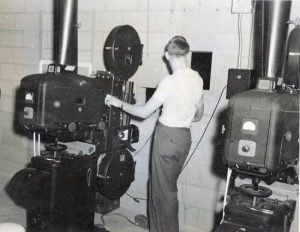
Digital projection has now replaced film worldwide. Cinema managers are now trained to operate the equipment. When films were projected in converted halls and fairgrounds in the early part of the 20th century, the projector, projecting inflammable 35mm nitrate film stock was often placed in the aisle. Often there would be no take up spool; the film falling into a basket. In 1909, because of many fires, the cinematograph act was introduced. This came into force on 1st January 1910 and projectors had to be placed in a fireproof projection room with fire shutters over the projection ports. A bucket of sand, a bucket of water and an asbestos blanket also had to be placed in the projection box. If there was a fire, a fire record would be played letting staff know, but not the public, preventing panic. The staff on hearing the tune would then get the public safely out. In many cases the public were totally unaware that there was a fire.
_________________________________________________________________________________________________________________________________________________

_________________________________________________________________________________________________________________________________________________________